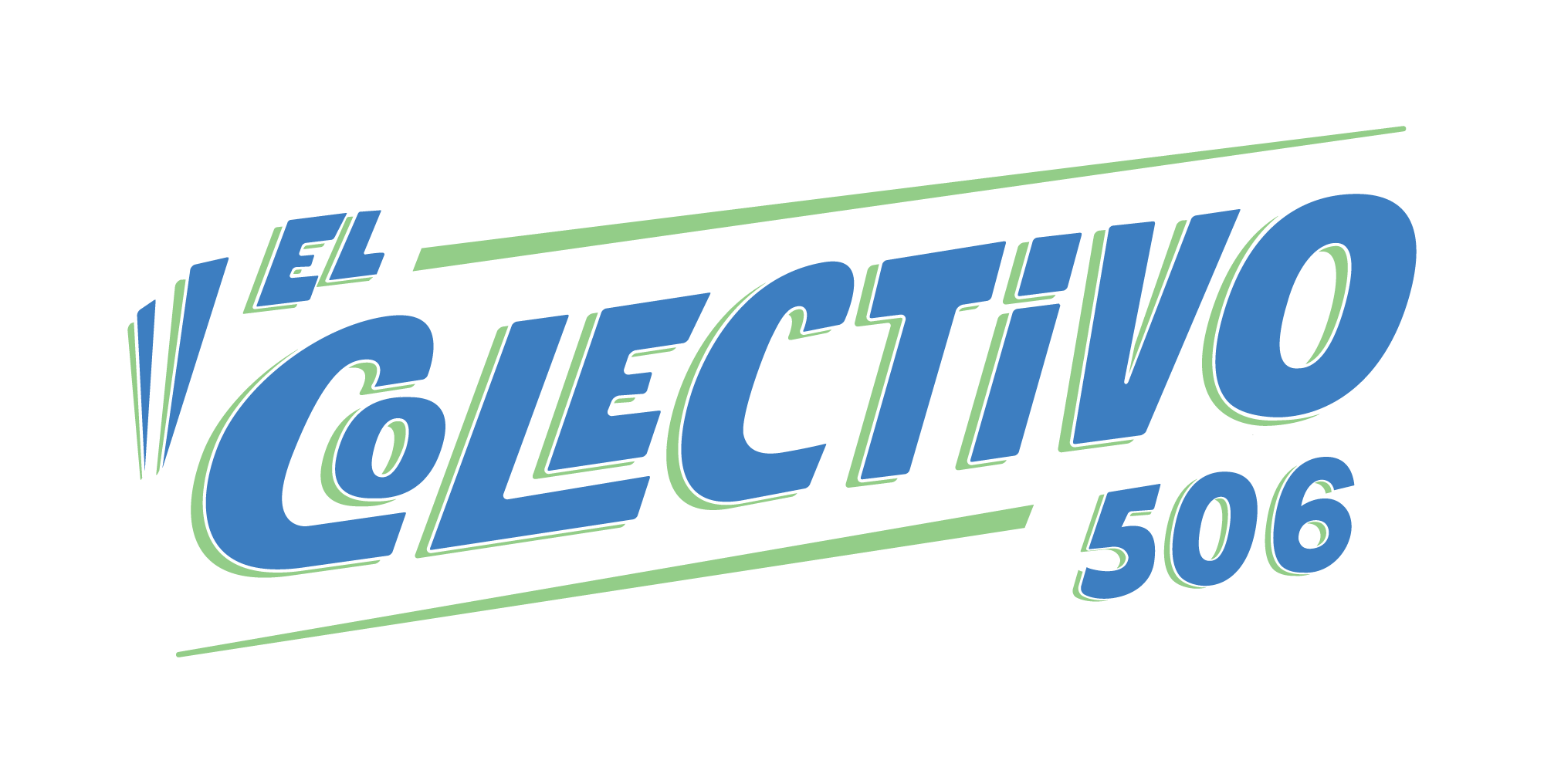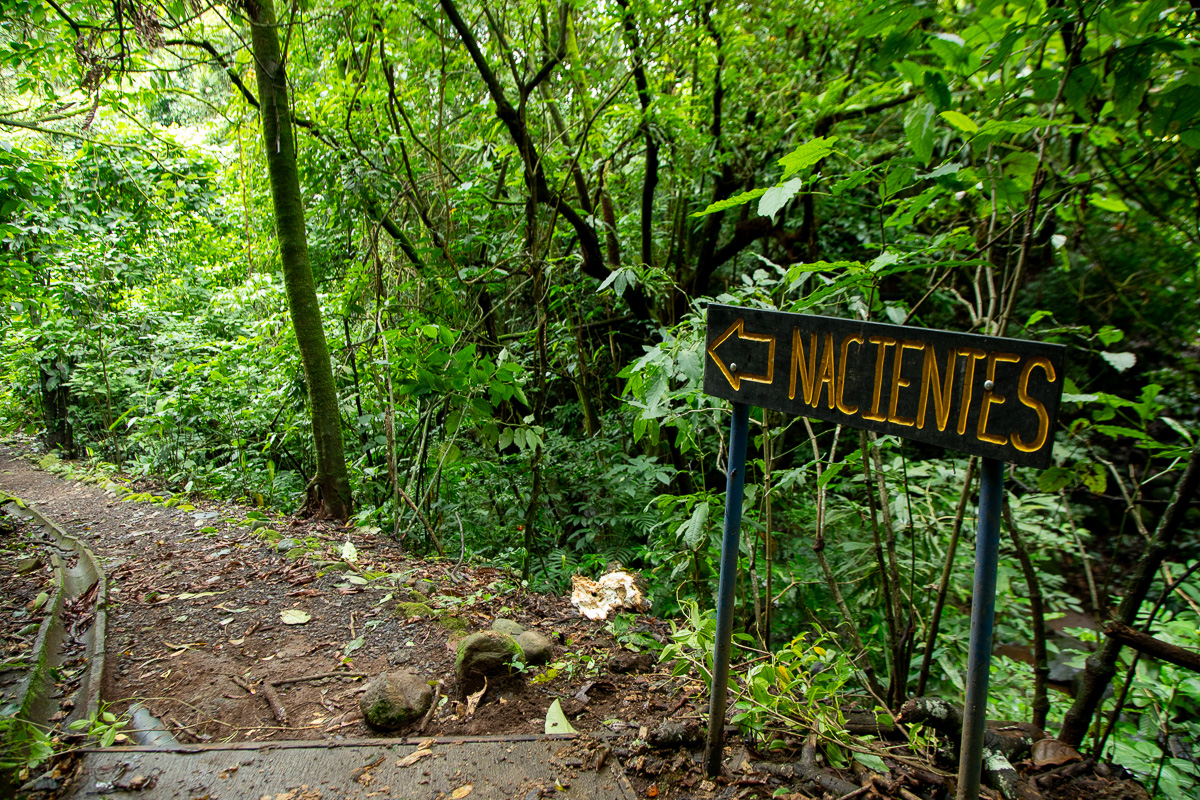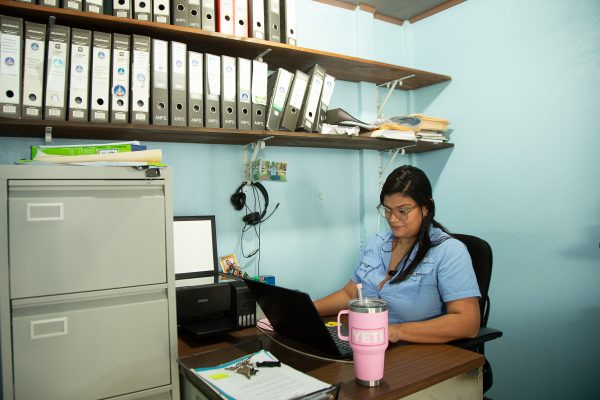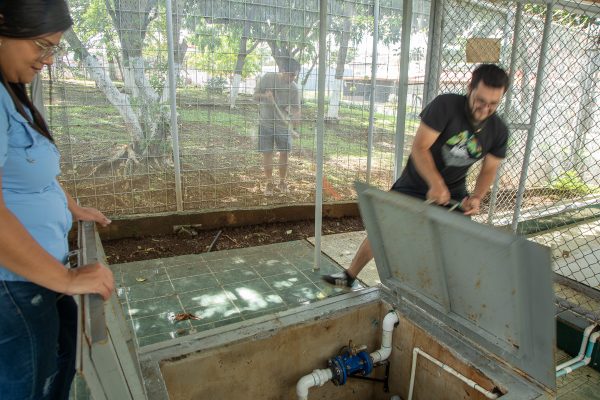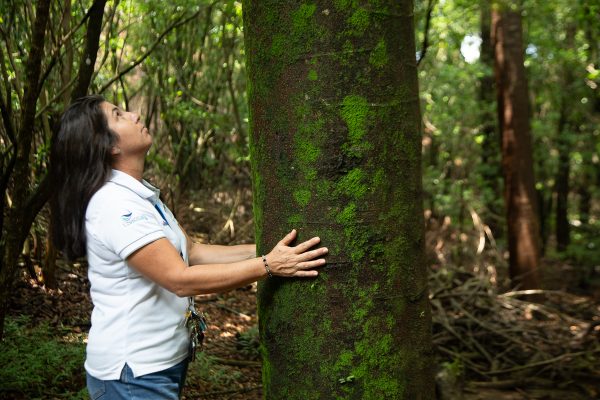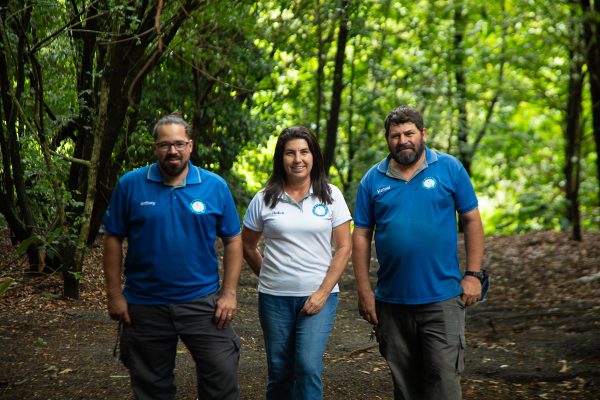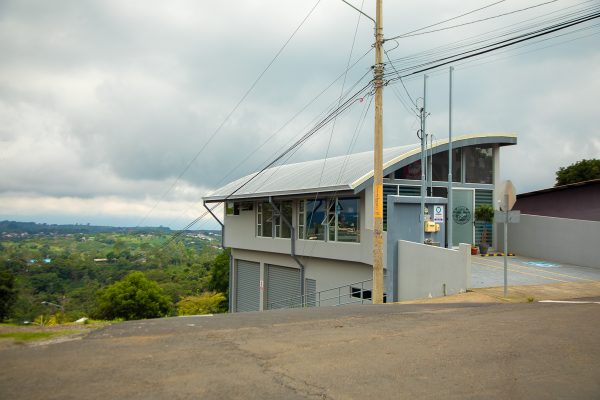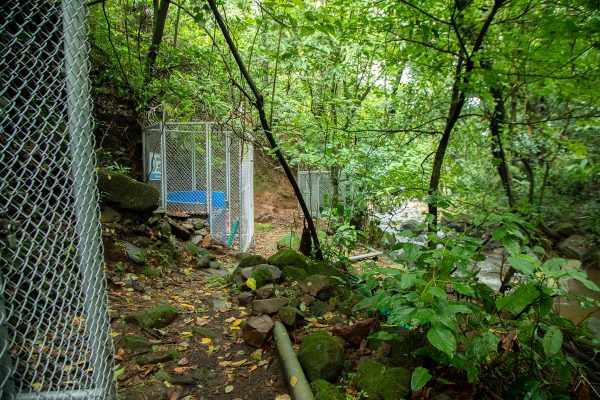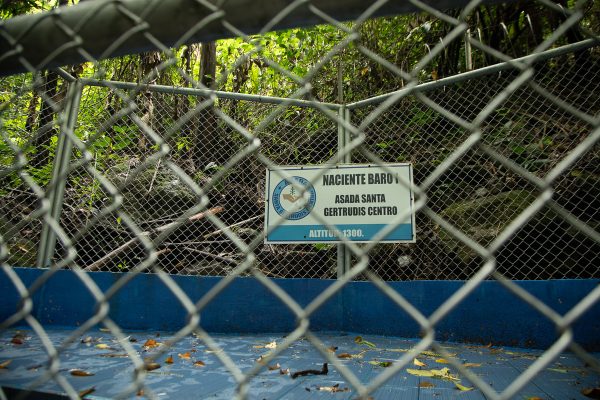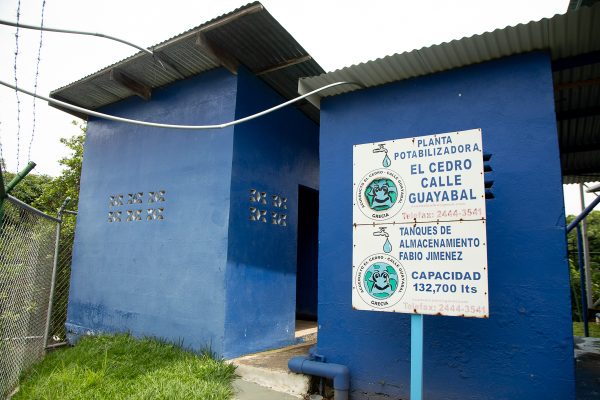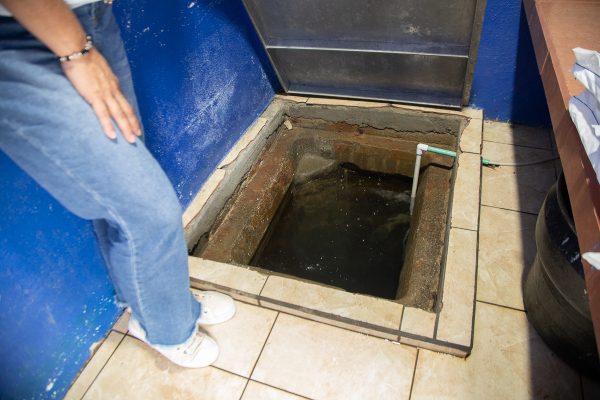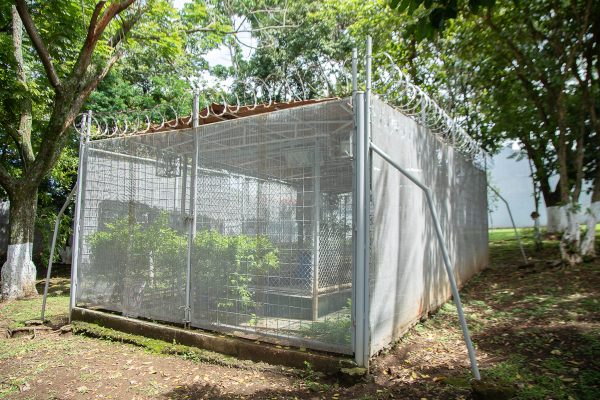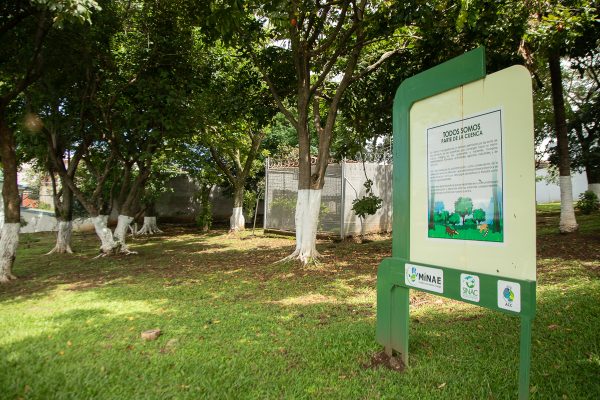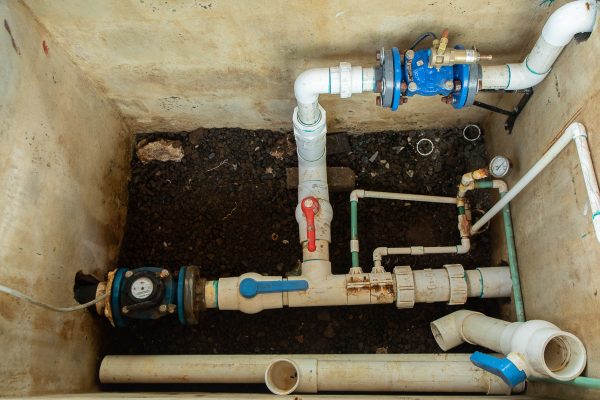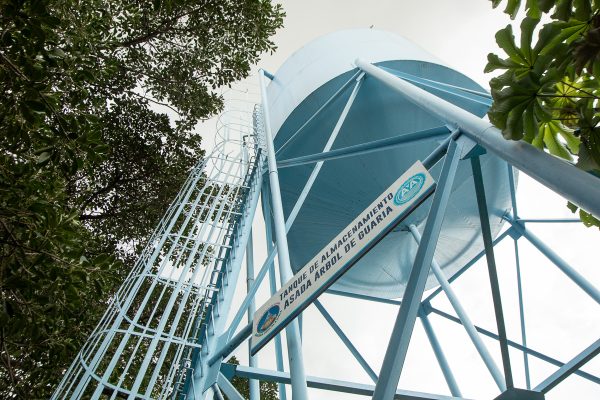“It makes me feel very proud because it’s a little treasure that’s now protected,” says Karina Villalobos. She’s referring to a plot of a little over 2,000 square meters where fruit trees and flowering shrubs have been planted alongside bee-shaped decorations. Karina says she now sees birds and insects she didn’t see before, instead of what used to be on display here: garbage, human and animal feces, and vandalism. That was the situation until just five months ago when a perimeter fence was installed in this park, home to the well that supplies the Urbanización Baviera and upon which 800 people depend.
Karina lives in Árbol de Guaria, a neighborhood that lies just a 15-minute walk away from the Central Park of Alajuela, which is the second most populous canton in Costa Rica and the central city of the province of Alajuela. Árbol de Guaria was once called Finca la Esperanza, which was divided into 300 lots, 280 of which have buildings and are clients of the ASADA de Árbol de Guaria, which Karina has been managing for the past 10 years.
ASADA stands for Association of Water and Sewerage Systems Administrators, which have existed in Costa Rica since the year 2000. Árbol de Guaria is one of 1,239 ASADAS in Costa Rica today: private non-profit organizations responsible for providing a public service. And not just any service—one that is a constitutional right.
In 2020, Costa Rica enshrined in its public constitution that “every person has the basic and inalienable human right to access to drinking water, which is essential for life,” and reiterated that “the supply of drinking water for the consumption of individuals and communities shall be a priority.”
However, fulfilling this obligation is not so easy.
One example is the fact that it took Karina almost 10 years to convince the Alajuela City Council that while the park is a public space, water protection should be a priority.
ASADA Santa Gertrudis Centro is another organization defending the constitutional right to water, but in a rural community located approximately 18 km northwest of Árbol de Guaria, in the Grecia canton of Alajuela. In Santa Gertrudis, the streets zigzag between coffee plantations, sugarcane fields, and houses with lush green gardens. Although the landscape looks very different from Árbol de Guaria, this community, too, has to deal with institutional bureaucracy. Its more than 900 members, as well as a history of community organizing as the town approaches its centennial celebrations, have allowed it to utilize its own resources and thus move forward, despite institutional lethargy.
Although these two ASADAs are very different, they and the other 1,237 ASADAs in Costa Rica share the same goal: providing quality water to their communities. And they both do so thanks to the same energy.
“Those of us who are involved in water resource management, apart from commitment and responsibility, have a lot of love for what we do,” says Hellen Alfaro, a native of Santa Gertrudis who has been an ASADA member and administrator since 2013.
However, this awareness of the importance of the ASADAs’ work is not widespread.
“For me, that’s a huge weakness in the communities, that detachment,” says Karina. “There’s no longer that unity to move forward. Here, at one point, [the community] came together to establish [this ASADA], but unity is needed to keep it going.”
Hellen, in her role as administrator, also echoes what Karina says: “Here, if we have to cut the water, we are all out of water.”
What is an ASADA?
ASADAs emerged as a legal structure in 2000, when its regulations (Executive Decree No. 42582-S-MINAE) took effect. However, this type of community organization to manage and protect drinking water sources was not new. Before the year 2000, primarily in rural areas of the country, there were Rural Water Supply and Sewerage Management Committees (CAAR), governed by the Community Development Law, Law No. 3859.
According to the State of the Nation Program(PEN), “by 2024, communal aqueducts will supply 33% of the national population. There are 500,559 water connections (subscribers) and a total of 1,375 communal operating entities. Of these, there are 1,239 legally constituted ASADAs with a Delegation Agreement, five Associations, 48 Indigenous Development Associations, 81 CAARs, and one cooperative.”
All of these communal water management bodies are supervised by the central government. The primary institution that regulates them is the Institute of Aqueducts and Sewers (AyA), whose official documentation explains that ASADAs must sign a Delegation Agreement that allows members to “cooperate in the administration, maintenance, operation, and development of a communal aqueduct, becoming a private organization providing a public service, delegated by AyA, on a non-profit basis.”
Another important national entity for the operation of an ASADA is the Public Services Regulatory Authority (ARESEP), which defines the rate that an ASADA can charge for the public service it provides.
Karina, from the ASADA Árbol de Guaria, explains that residents in Baviera pay a basic rate of ₡3,100 (about $6), plus the hydrant fee and a tiered rate based on each subscriber’s water consumption. The ASADA Árbol de Guaria boasts a 0% delinquency rate on payments, which Karina says helps make it a very stable organization.
Marco Vinicio Alfaro is the president of the Board of Directors of the ASADA Santa Gertrudis and has been actively involved with the organization for more than 30 years. He and Hellen recall how the community’s aqueduct was essentially born from the efforts and vision of the community’s residents in the mid-20th century.
“People were very supportive. When we asked for help to go and do work in the higher areas—to go and fix pipes, to lay pipes—people would show up. You would make a mass announcement—’The aqueduct requires so many people to go and lay a pipe, we leave on such a day at such a time’—and people would arrive,” Marco says. “Whoever couldn’t participate would pay someone else to go and do it in his her place. All of this was what formed the community and its development.”
For many years, access to water in Santa Gertrudis was unlimited and available to all families equally. In the 1990s, for example, the Santa Gertrudis Pipeline Committee—the entity that managed the aqueduct from 1978 to 1998—charged an annual fee, the same for all subscribers, of approximately ₡1,500 ($3). It was at the end of this decade that the leaders decided to implement the micrometer system in each home so that homeowners would pay only for the water they consumed.
“That time, the gym was packed. When we announced we were going to install water metering, charge new rates, and raise the price of water, everyone came to see what the deal was,” Marco recalls. “There was enough water, but since we paid so little per year and people spent whatever they wanted, there wasn’t that culture [of protection].”
However, that vision of water resources has been changing.
“When the community loses access to water because there is a pipeline failure upstream, the community practically collapses. The schools, restaurants, bakeries, butcher shops, and the EBAIS ([local health team] all depend on water; without water, they can’t do anything,” says Hellen. “The important thing is that those values of continuing to take care of what we have and thinking about the future, thinking about the next generations, prevail. That way, what we do will keep working for many years to come.”
It’s not just about managing water
Although Árbol de Guaria and Santa Gertrudis Centro’s mission is to provide water service to their communities, their actions go far beyond collecting water, chlorinating it, installing pipes and meters, and collecting the monthly bill. They’re also responsible for providing environmental education about the proper use of the resource to ensure its long-term sustainability.
Both ASADAs carry out reforestation, environmental education, and water resource stewardship programs in local primary and high schools. They also hold community events to promote environmental stewardship and solid waste management programs through recycling. They often provide learning opportunities for university students.
The lessons learned from communal water management
Andrés Araya is an Agricultural Engineer and researcher at the Center for Studies on Sustainable Development at National Technical University (UTN). He has over 10 years of experience studying and working with ASADAs across the country. He is convinced that ASADAs “do a solid job of enacting the human right [to water], while neither the AyAs nor the municipalities do.
“They know that the work they do is important for people’s health and, ultimately, for community development,” he adds. “If there’s no board, if there’s no properly functioning ASADA, the water starts to run dirty. People start to get sick. The effect is direct, and you can’t be so apathetic. You can’t take water for granted.”
However, people do take it for granted.
“There are so many things behind an aqueduct that people have no idea about,” says Karina from Árbol de Guaria. “Sometimes users come and I show them the control panel, and they don’t know what it is; they don’t know that the well is 75 meters deep. I feel that this lack of knowledge has been one of the ASADAs’ weaknesses.”
In other words, ASADAs have learned that to be successful, they must educate their members and subscribers so they know that the service they receive requires a lot of work.
“I’ve also learned that transparency, order, and training are essential,” says Karina. She’s a professional administrator, but still experienced a learning curve at the ASADA. She’s found that training for volunteers and staff, both in administration and water supply management, is essential to the association’s success.
“It’s a communal enterprise,” says Marco, adding that ASADAs must pay special attention to caring for their water sources and investing in infrastructure, both operational and administrative.
In Santa Gertrudis Centro, they have invested in purchasing 10,500 m2 of land where two of their three springs are located. They have reforested and hope to continue expanding.
Hellen sees her staff as part of that infrastructure. She says that she highly values the work of the two plumbers who work for ASADA Santa Gertrudis Centro, Harold Picado Espinoza and Anthony Nuñez Rojas. This duo’s work requires 24/7 dedication.
On the other hand, Marco says that it’s essential to recognize that “the number of subscribers has a direct impact on the ASADAs’ capacity to act,” and that, therefore, in many cases, it is better for smaller aqueducts to join forces and integrate their work.
Difficulties in communal water management
Andrés, the UTN researcher, says that ASADAs face three primary difficulties not only in carrying out their work to the best of their ability, but also when it comes to growth: scale, dispersion, and administrative weakness.
He explains that under 10% of ASADAs have more than 1,000 subscribers, and approximately 50% have fewer than 150. Having few subscribers means that some ASADAs lack sufficient income to meet the financial challenges of maintaining the water supply, especially those that also have to deal with dispersion because their subscribers are widely spaced and/or the water intakes are far apart, making maintenance of this piping system costly and complex.
The administrative weakness is twofold. On the one hand, ASADAs with limited income cannot cover the cost of hiring an administrator or having permanent staff to respond to emergencies, so they rely on the volunteer work of their members, primarily the members of the Board of Directors. Therefore, the projects and improvements that ASADAs could and should implement often fail to materialize because the availability of volunteer members is limited.
“They work out of love for their community,” says Karina of the board of Árbol de Guaria. The members of a Board of Directors don’t receive a salary, but rather a diet of ₡6,000 (about $12) per work session. “The AyA, or ARESEP, should establish some regulations whereby the Boards of Directors are paid, even if it’s a symbolic salary, so they can serve.”
According to Andrés, the limited time board members can dedicate to the project often has a direct impact on monetizing the service.
“Often, due to weak administrative processes, they say they’re afraid to charge the fee established by ARESEP,” he explains.
Another level of administrative weakness occurs when an ASADA has a low number of members—people who use water from the organization but who choose to be official members as well and share in the responsibility of management. Although both ASADAs serve a considerable number of people, Árbol de Guaria has fewer than 100 members, and Santa Gertrudis Centro has 120; that means that the number of people who can make decisions about the operation of the aqueduct is very small compared to those who benefit from the service. For both ASADAs, this problem is not only a lack of interest among those who receive the service, but also a lack of participation among many who would like to. To become members, they must own a plot of land in their name within the ASADA’s coverage area. This excludes tenants, women who do not own property, and young families living on properties owned by parents or relatives.
This inability to recruit more members prevents generational renewal. In the case of Santa Gertrudis, for example, 70% of members are older adults. The few young people in the area do not want to take on the responsibility of leading the association.
Andrés, in his research work, finds another factor that not only hinders but also limits the associations’ actions: a vertical relationship between AyA and the ASADAs. For him, it is necessary “for AyA to view the ASADAs not as a child, but as a sibling, as a collaborator.”
At the national level, according to official documentation, the ASADAs are the second-largest water authority in the country, significantly more than all municipalities combined. However, they still depend on the AyA’s close supervision to operate.
“Our big [problem] is the approvals from AyA,” Marco says. “We submit a query to AyA, and those queries sit there for six or seven months without a response, and that doesn’t let us move forward.”
These types of consultations range from technical studies and asset liquidation to requests for bank financing to make improvements. In the case of Santa Gertrudis, thanks to its sound financial management, it has been able to move forward with projects such as the installation of a new catchment tank, 10 times larger than the one it replaced, and the creation of an office to operate and serve the public. None of these projects would be a reality at this time if they depended on the approval of the AyA.
“All of that takes a lot of time, much more than it should,” says Marco.
“Papers come and go, papers expire, you have to keep renewing them. So it’s very exhausting,” Hellen adds.
The secret ingredient is associativity
“Association brings us great things,” says Marco. “I think it sets the fundamental goals for us to keep moving forward. If we don’t associate, we continue to be minimized by organizations.”
That’s why champions of the ASADAs are now seeking not only to promote citizen participation in these organizations, but also to unite ASADAs in second-tier organizations such as leagues, unions, and federations, to achieve greater impact.
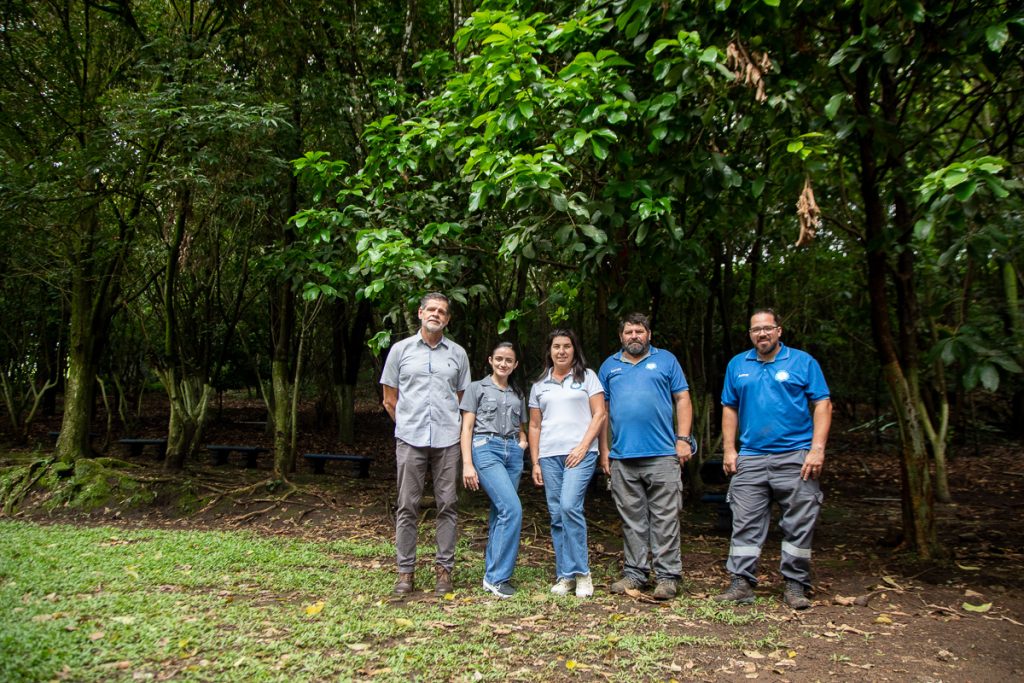
“When we have to go out and demand something for water, for the environment, and we do it in large numbers, people will pay attention to us. But if we continue on our own, thinking we’ve already resolved all the issues, they won’t give us any importance,” Marco explains.
Serving on an ASADA “is a commitment that generates actions to achieve a specific goal that benefits many people. [That’s important] especially in times where everything is fast, immediate, and where there’s individualism,” says Andrés. “It’s a very virtuous thing; you learn a lot. They are very hardworking people, with high levels of leadership and commitment, who sacrifice time off and family time for their commitment to water resources and their communities.”
______________________________
This article was produced with the support of the Regional Coalition on the Right to a Healthy Environment (COREDAM) and the Association for Generations of Peace (ASDEPAZ).

